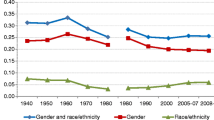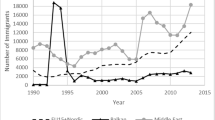Abstract
We analyze the role of the demographic and human capital characteristics of minorities in the US in explaining their high occupational segregation with respect to whites and the extent to which they are locked into low-paying jobs. We measure conditional segregation based on an estimated counterfactual distribution in which minorities are given the relevant characteristics of whites. Our results show that the different levels of attained education by ethnicity and race explain a substantial share of occupational segregation among non-whites in the US, while English skills or immigration status are especially relevant for explaining segregation among Hispanics and Asians.
Similar content being viewed by others
References
Albelda, R.: Occupational segregation by race and gender, 1958–1981. Ind. Labor Relat. Rev. 39(3), 404–411 (1986)
Alonso-Villar, O., Del Río, C.: Local versus overall segregation measures. Mat. Soc. Sci. 60(1), 30–38 (2010)
Alonso-Villar, O., Del Río, C., Gradín, C.: The extent of occupational segregation in the US: differences by race, ethnicity, and gender. Ind. Relat. 51(2), 179–212 (2012)
Aslund, O., Skans, O.N.: How to measure segregation conditional on the distribution of covariates. J. Popul. Econ. 22, 971–981 (2009)
Atkinson, A.B.: On the measurement of poverty. Econometrica 55(4), 749–764 (1987)
Bayer, P., McMillan, R., Rueben, K.S.: What drives racial segregation? New evidence using Census microdata. J. Urban Econ. 56, 514–535 (2004)
Caliendo, M., Kopeinig, S.: Some practical guidance for the implementation of propensity score matching. J. Econ. Surv. 22(1), 31–72 (2008)
Cancian, M., Reed, D.: Family structure, childbearing, and parental employment: implications for the level and trend in poverty. In: Cancian, M., Danziger, S. (eds.) Changing Poverty, Changing Policies, pp. 92–121. Russell Sage Foundation, New York (2009)
Carrington, W.J., Troske, K.R.: On measuring segregation in samples with small units. J. Bus. Econ. Stat. 15(4), 402–409 (1997)
Carrington, W.J., Troske, K.R.: Interfirm segregation and the black/white wage gap. J. Labor Econ. 16(2), 231–260 (1998)
Chakravarty, S., Silber, J.: A generalized index of employment segregation. Mat. Soc. Sci. 53(2), 185–195 (2007)
Chakravarty, S., D’Ambrosio, C., Silber, J.: Generalized Gini occupational segregation indices. Res. Econ. Inequal. 17, 71–95 (2009)
Chantreuil, F., Trannoy, A.: Inequality decomposition values: the trade-off between marginality and efficiency. J. Econ. Inequal. (2011). doi:10.1007/s10888-011-9207-y
Chiswick, B.R., Miller, P.W.: Educational mismatch: are high-skilled immigrants really working at high-skilled jobs and the price they pay if they aren’t? In: Chiswick, B.R. (ed.) High Skilled Immigration in a Globalized Labor Market, pp. 111–154. American Enterprise Institute, Washington D.C. (2011)
Del Río, C., Alonso-Villar, O.: Occupational segregation measures: a role for status. Res. Econ. Inequal. 20, 37–62 (2012)
DiNardo, J., Fortin, N.M., Lemieux, T.: Labor market institutions and the distribution of wages, 1973–1992: a semiparametric approach. Econometrica 64, 1001–1044 (1996)
Duclos, J-Y., Makdissi, P.: Restricted and unrestricted dominance for welfare, inequality, and poverty orderings. J. Public Econ. Theory 6(1), 145–164, 02 (2004)
Duncan, O.D., Duncan, B.: A methodological analysis of segregation indexes. Am. Sociol. Rev. 20(2), 210–217 (1955)
Foster, J.E., Shorrocks, A.F.: Poverty orderings. Econometrica 56(1), 173–177 (1988)
Foster-Bey, J.A. Jr: Did spatial mismatch affect male labor force participation during the 1990s expansion? In: Mincy, R.B. (ed.) Black Males Left Behind, pp. 121–146. The Urban Institute Press (2006)
Frankel, D.M., Volij, O.: Measuring school segregation. J. Econ. Theory 146(1), 1–38 (2011)
Gradín, C.: Race and income distribution: evidence from the US, Brazil and South Africa. Rev. Dev. Econ. (2012, forthcoming)
Hanushek, E.A., Rivkin, S.G.: School Quality and the Black-White Achievement Gap. Working Paper 12651, National Bureau of Economic Research (2006)
Hellerstein, J.K., Neumark, D.: Workplace segregation in the United States: race, ethnicity, and skill. Rev. Econ. Stat. 90(3), 459–477 (2008)
Holzer, J.H., Raphael, S., Stoll, M.A.: How do employer perceptions of crime and incarceration affect the employment prospect of less-educated young black men? In: Mincy, R.B. (ed.) Black Males Left Behind, pp. 67–85. The Urban Institute Press (2006)
Hutchens, R.M.: Segregation curves, Lorenz curves, and inequality in the distribution of people across occupations. Mat. Soc. Sci. 21, 31–51 (1991)
Hutchens, R.M.: One measure of segregation. Int. Econ. Rev. 45(2), 555–578 (2004)
Hutchens, R.M.: Measuring Segregation When Hierarchy Matters. Working Paper, ILR, Cornell University (2006)
Hutchens, R.M.: Occupational segregation with economic disadvantage: an investigation of decomposable indexes. Res. Econ. Inequal. 17, 99–120 (2009)
Hutchens, R.M.: A response to Paul Jargowsky’s comments. Res. Econ. Inequal. 17, 125–127 (2009)
Jahn, J., Schmid, C.F., Schrag, C.: The measurement of ecological segregation. Am. Sociol. Rev. 12(3), 293–303 (1947)
Jargowsky, P.A.: Comment on Hutchens’ ‘occupational segregation with economic disadvantage: an investigation of decomposable indexes’. Res. Econ. Inequal. 17, 121–124 (2009)
Kalter, F.: Measuring Segregation and Controlling for Independent Variables. MZES Working Paper 19, Mannheim (2000)
Karmel, T., MacLachlan, M.: Occupational sex segregation-increasing or decreasing? Econ. Rec. 64(3), 187–195 (1988)
King, M.C.: Occupational segregation by race and sex, 1940–88. Mon. Labor Rev. 115, 30–37 (1992)
Lemieux, T.: Decomposing wage distributions: a unified approach. Can. J. Econ. 35, 646–88 (2002)
Massey, D.S.: Effects of socioeconomic factors on the residential segregation of Blacks and Spanish Americans in US Urbanized Areas. Am. Sociol. Rev. 44(6), 1015–1022 (1979)
McLanahan, S.: Single mothers, fragile families. In: Edwards, J., Crain, M., Kalleberg, A.L. (eds.) Ending Poverty in America, pp. 77–87. The New Press (2007)
Maxwell, N.L.: English language and low-skilled jobs: the structure of employment. Ind. Relat. 49(3), 457–465 (2010)
Mora, R., Ruíz-Castillo, J.: The Statistical Properties of the Mutual Information Index of Multigroup Segregation. Working Paper 09-84, Economic Series (48), Universidad Carlos III de Madrid (2009)
Queneau, H.: Trends in occupational segregation by race and ethnicity in the USA: evidence from detailed data. Appl. Econ. Lett. 16, 1347–1350 (2009)
Rawlston, V., Spriggs, W.E.: A logit decomposition analysis of occupational segregation: an update for the 1990s of Spriggs and Williams. Rev. Black Polit. Econ. 29(4), 91–96 (2002)
Reardon, S.F., Firebaugh, G.: Measures of multigroup segregation. Sociol. Method. 32, 33–76 (2002)
Reardon, S.F.: Measures of ordinal segregation. Res. Econ. Inequal. 17, 129–155 (2009)
Sastre, M., Trannoy, A.: Shapley inequality decomposition by factor components: some methodological issues. J. Econ. 9, 51–89 (2002)
Sethi, R., Somanatham, S.: Racial inequality and segregation measures: some evidence from the 2000 census. Rev. Black Polit. Econ. 36(2), 79–91 (2009)
Shorrocks, A.: Decomposition procedures for distributional analysis: a unified framework based on the Shapley value. J. Econ. Inequal. (2012). doi:10.1007/s10888-011-9214-z
Sianesi, B.: An evaluation of the Swedish system of active labour market programmes in the 1990s. Rev. Econ. Stat. 86(1), 133–155 (2004)
Silber, J.: Occupational segregation indices in the multidimensional case: a note. Econ. Rec. 68, 276–277 (1992)
Spriggs, W.E., Williams, R.M.: A Logit decomposition analysis of occupational segregation: results for the 1970s and 1980s. Rev. Econ. Stat. 78, 348–355 (1996)
Tomaskovic-Devey, D., Zimmer, C., Stainback, K., Robinson, C., Taylor, T., McTague, T.: Documenting desegregation: segregation in American workplaces by race, ethnicity, and sex, 1966–2003. Am. Sociol. Rev. 71, 565–588 (2006)
Author information
Authors and Affiliations
Corresponding author
Electronic Supplementary Material
Below is the link to the electronic supplementary material.
Rights and permissions
About this article
Cite this article
Gradín, C. Conditional occupational segregation of minorities in the US. J Econ Inequal 11, 473–493 (2013). https://doi.org/10.1007/s10888-012-9229-0
Received:
Accepted:
Published:
Issue Date:
DOI: https://doi.org/10.1007/s10888-012-9229-0




